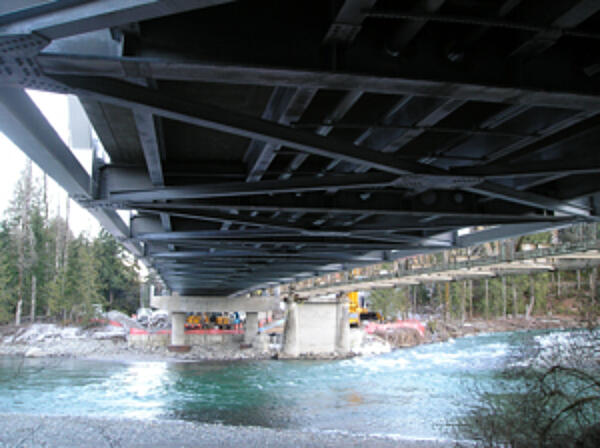Economic Advantages

In addition to building structures that are environmentally-friendly, for true sustainability these structures must also be economically responsible for future generations. Hot-dip galvanized steel can provide economic savings both initially and throughout the life of a project, freeing up money for new construction rather than costly maintenance.
There has long been a perception in the specifying community that hot-dip galvanized steel is cost prohibitive on an initial basis. However, due to regular process improvements, galvanized steel is not only competitive but often less expensive than other corrosion protection systems initially. Furthermore, because of quick turnaround and erection, utilizing hot-dip galvanized steel often provides wider-ranging cost savings during construction.
Maintenance-free longevity also delivers economic value when life-cycle costs are being analyzed. Often the initial cost of hot-dip galvanized steel is the final cost which can be amortized over the entire life of the project. The low economic impact makes hot-dip galvanizing sustainable for future generations.
Cost Case Study
Using the galvanizing cost data obtained through a 2021 survey of North American hot-dip galvanizers and paint cost data taken from a paper produced in 2021 by KTA-Tator (consulting firm specializing in protective coatings, specifically paint) the AGA developed an online tool called the Life-Cycle Cost Calculator. This is an example using the online calculator, which follows the calculation in ASTM A1068, to conduct a quantitative analysis comparing hot-dip galvanizing to four paint systems, as well as a duplex system and metallizing with defined maintenance schedules, in one of the ASTM classified environments.
For this case study, we are analyzing:
- Typical mix of steel shapes/sizes
- 50,000 square foot short-span bridge
- 70-year design life
- Moderately Industrial (C3) Environment
Initial Cost
Initial costs take into account the material (paint, metallizing, etc.), as well as the number of coats. Additionally, it examines the cleaning method, where the application will be done, and labor accordingly. All painted systems in this example were cleaned to an SP-10 Automated surface prep, the duplex was to SP-16 (same as ASTM D6386) and the Metallizing example to the standard near white metal required. Galvanizing is an all-inclusive price, as the way the galvanizer quotes the material includes the surface preparation, material and labor costs.
As mentioned before, it is not recommended to analyze only the initial cost for a corrosion protection system. However, if it is the only analysis, galvanizing is still a solid choice, as it is often initially less expensive or very cost competitive with other coating systems. Keep in mind these costs are all coming from the manufacturer (paint manufacturer and/or galvanizer) and do not take into account fabricator markup which may be assigned at varying rates dependent on the material (i.e. galvanizing may be marked up more if the fabricator has his own paint facility).
Life-Cycle Cost
Comparing the life-cycle costs of a galvanizing system to the five other systems as well as a duplex system (galvanized + painted), a practical maintenance cycle was used over the prescribed lifetime of the project. A 70-year lifetime for this analysis was selected as a realistic timeframe before modification. This is opposed to an ideal maintenance cycle, which would be even more costly for all of the other systems which require maintenance. When analyzing life-cycle costs, you must also account for the time value of money using Net Future Value (NFV) and Net Present Value (NPV) calculations.
For this example, we used:
- 3% inflation
- 2% interest
When life-cycle costs are considered, hot-dip galvanizing is the most economical system for corrosion protection. In fact, this analysis does not even include the hidden (or indirect) costs associated with touch-up, maintenance, and full repainting required for paint systems. If deviations from the practical maintenance schedule occur, life-cycle costs could be significantly higher than indicated.
After 70-years of life, the life-cycle cost of the galvanizing equals the initial cost as no maintenance is required in this environment. Also, when comparing the costs of galvanizing to other systems, the cost savings is significant. The second best option over the life of the project in this example is actually the duplex system of paint over galvanizing because as mentioned before, the galvanized primer allows less maintenance cycles to the painted system than the same system (with IOZ primer) on bare steel.
Also, of note, often the least expensive systems initially (Epoxy/Polyurethane, Epoxy/Epoxy) are the most expensive in life-cycle cost (because they require more maintenance). Even though the metallizing system requires less maintenance, the cost to metallize (and touch up with metallizing in the field) is much higher than it is to use paint in the field.